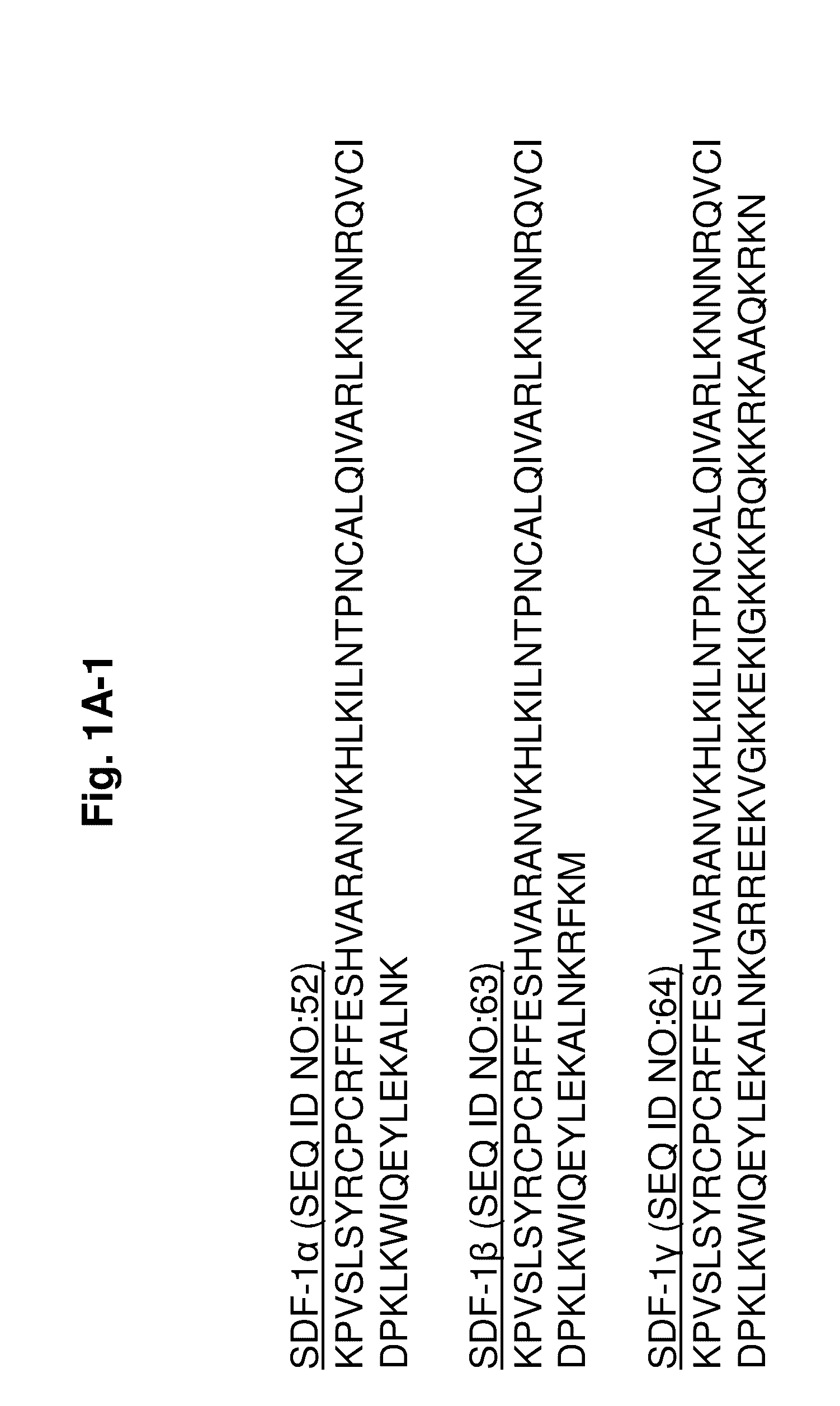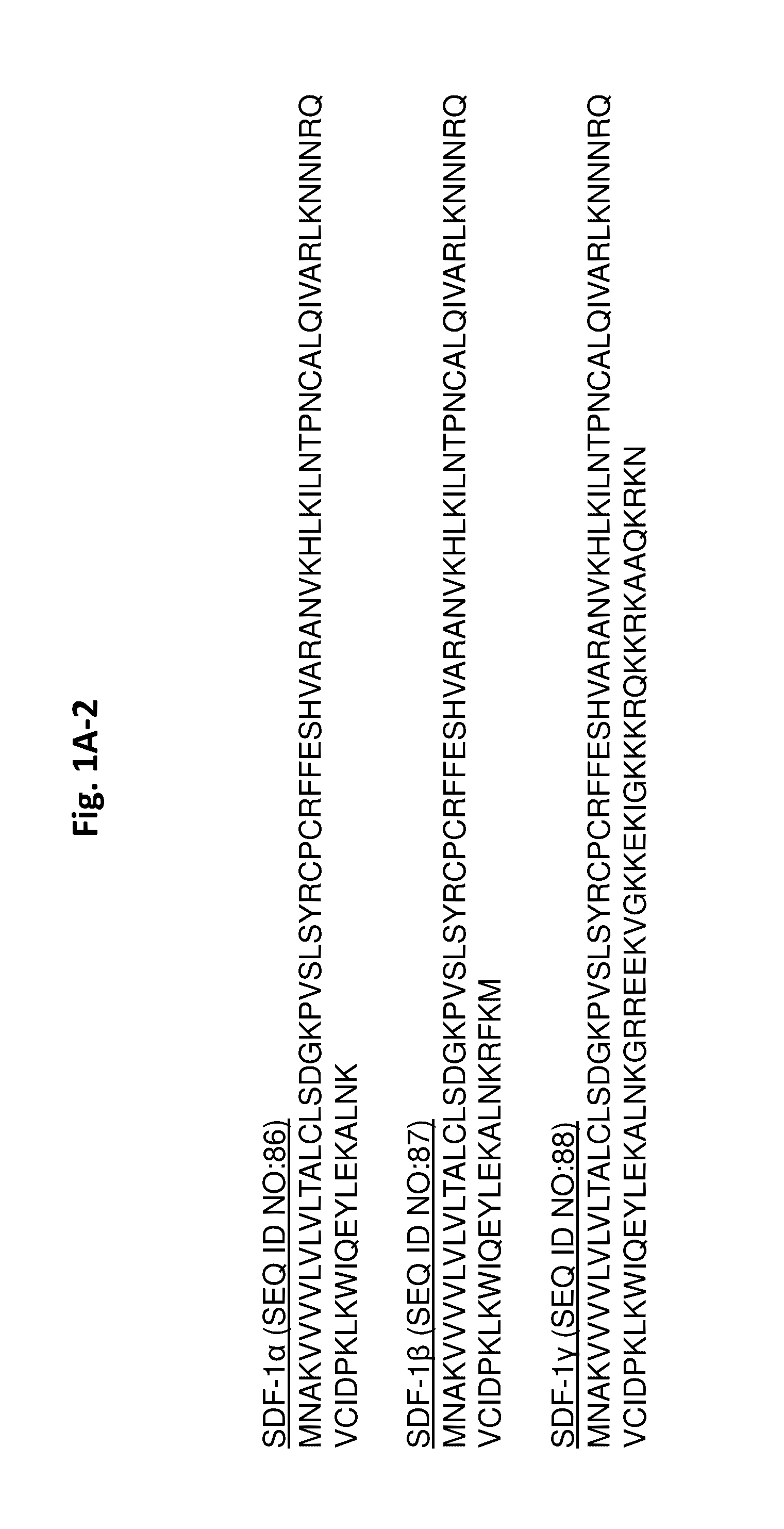Protease-resistant mutants of stromal cell derived factor-1 in the repair of tissue damage
a technology of stromal cell derived factor and protease resistance, which is applied in the direction of animal/human proteins, anti-mimetic/scaffolds, pharmaceutical non-active ingredients, etc., can solve the problem of insufficiency of the naturally occurring myocardial repair process, and achieve the effect of treating or reducing the likelihood of tissue damag
- Summary
- Abstract
- Description
- Claims
- Application Information
AI Technical Summary
Benefits of technology
Problems solved by technology
Method used
Image
Examples
example 1
Initial Cleavage Rates of a FRET-Based Peptide Library
[0119]Peptides containing the first 8 amino acids of SDF-1 (KPVSLSYR) and all possible single amino acid mutations at position 3, 4, 5, or 6 (spanning the MMP-2 cleavage site) were synthesized, 77 peptides total (Anaspec, San Jose, Calif.). All peptides were synthesized with a fluorescent 7-methoxycoumarin-3-carboxylic acid (MCA) residue at the N-terminus and a quencher lysine-dinitrophenol (Dpn) residue at the C-terminus. Purity of peptides was confirmed with HPLC and mass spectrometry. Enzymatic cleavage of these peptides separated MCA from Dpn, resulting in an increased fluorescence. Peptides (10 μM) were then incubated with activated MMP-2 (Table 1), leukocyte elastase (Table 2), or cathepsin G (Table 3) (1.4 nM) in TNCB buffer (50 mM Tris, pH 7.5, with 10 mM calcium chloride, 150 mM sodium chloride, and 0.05% BRIJ 35) or phosphate-buffered saline (PBS) at 21° C. Fluorescence was measured at 340 nm excitation and 405 nm emiss...
example 2
Identification and Characterization of SDF-1 Variants Resistant to MMP-2 Cleavage
[0121]The site where SDF-1 is cleaved by MMP-2, leukocyte elastase, and cathepsin G is also the receptor binding site of SDF-1. Thus, mutations that make SDF-1 resistant to proteases may also interfere with receptor binding and activation. Based on the FRET-peptide library initial cleavage rates, mutations were selected for cloning into an E. coli expression vector. Proteins were expressed in E. coli and purified with cation-exchange chromatography and reverse-phase HPLC. Activity of these proteins was tested in a Jurkat T-lymphocyte migration assay, CXCR4 (cAMP) receptor activation assay, and CXCR7 β-arrestin binding assay. For these experiments and other experiments described herein, data were analyzed with 2-tail t-tests if 2 independent samples were compared and with one-way ANOVA if more than 2 independent samples were present, followed by multiple comparisons with Bonferroni corrections. Data are ...
example 3
SSDF-1(S4V) has the Same Receptor Specificity as Native SDF-1
[0127]The activity of SSDF-1(S4V) was evaluated in Jurkat cell migration assays (FIG. 2A) and CXCR4 and CXCR7 receptor activation assays and compared to native SDF-1 and SSDF-1, as described above. The EC50 for CXCR4 receptor activation was 20 nM with SSDF-1(S4V) compared to 5.4 nM for SDF-1 (measured by the decrease in cAMP by Gi activation; FIG. 2B) and 28 nM for SSDF-1(S4V) compared to 3.8 nM for SDF-1 (measured by binding of β-arrestin to the CXCR4 receptor, FIG. 2C). Together, these data indicate that SSDF-1(S4V) is an agonist of CXCR4, but with nanomolar potency that is 4- to 7-fold lower than native SDF-1. Compared to SDF-1, SSDF-1(S4V) has similar potency on CXCR7 binding to β-arrestin (FIG. 2D). SSDF-1, which is different from native SDF-1 by an extra serine at the N-terminus, which provides resistance against DPPIV, had a similar profile in Jurkat cell migration experiments. To rule out a shift in CXCR receptor s...
PUM
 Login to View More
Login to View More Abstract
Description
Claims
Application Information
 Login to View More
Login to View More - R&D
- Intellectual Property
- Life Sciences
- Materials
- Tech Scout
- Unparalleled Data Quality
- Higher Quality Content
- 60% Fewer Hallucinations
Browse by: Latest US Patents, China's latest patents, Technical Efficacy Thesaurus, Application Domain, Technology Topic, Popular Technical Reports.
© 2025 PatSnap. All rights reserved.Legal|Privacy policy|Modern Slavery Act Transparency Statement|Sitemap|About US| Contact US: help@patsnap.com



